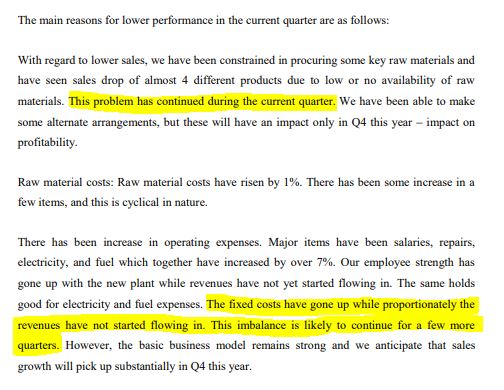Firstly, thanks to all the seniors and members who have made this thread so insightful.
I’ve been following NGL for a few months and trying to understand the business.
Have been reading ValuePickr forums and decided to start with Business Model Canvas first (before jumping to Business Quality Insights and the recent Mental Models Framework) , following is my analysis (the underlined questions in the attachment are the things which I need help in, to understand the business better and are reproduced below for everyone’s convenience) NGL_Business Model Canvas_Ansh-Gupta.pdf (72.9 KB)
Request you all to throw some light on this 
-
Given that NGL operates in unregulated and price sensitive markets, how do the customers react when the company increase prices? (the company mentioned in AGM’19 that about 10-15% growth came from price increase)
The objective for asking this is to understand how sustainable is this practice going forward
-
When selling products to customers, how is the pricing decided exactly?
Is the price fixed for everyone/does it depend on quantity/varies by the size of customer/else
-
How does the company approach/discover new customers?
There were a few other questions too which might not be relevant (I wasn’t sure, therefore separating them from the above ones):
a) For either imports/exports, they must be using a partner, right? Is there a need to dig into this in terms of how it can affect the business
b) Since 80-85% raw materials are available domestically, is there a need to look into the concentration of suppliers? In terms of how a supply chain disruption may be caused if the company is dependent on 1-2 suppliers only?
c) Since the capex requirement is huge, is there any alternative for this? Do similar companies rent factories instead?
Besides analyzing the business, I tried to gain some insights on Sustainability, Longevity, Scalability and Peer Comparison, would love to hear everyone’s views on the same:
1. Sustainability
-
For every Rs 100 sale, ~ Rs 43 is used in fixed capital investment and ~ Rs 31 is used in working capital, so the only way for the company to meaningfully grow is keep increasing sales at 15-20% every year
-
The above point also suggests that NGL Finechem is not a business which can cause ‘disproportionate growth’ but can still grow at 15-20%
-
NGL’s numbers for FC and WC are pretty similar to that of Sequent, so I’m assuming it cannot be improved upon
(The numbers for working capital and fixed capital have been taken from ‘Price Implied Expectation’ from the mental models thread excel)
The question about sustainability is that can the figures of 15%+ sales growth, 20-25% ROE, 20% ROIC be continued? Why/Why not?
I’m of the opinion that since sales growth is not too magnificent (nothing like 30-40% YoY) and the company has shown that it’s niche strategy is working, it can be sustained which will further drive the other metrics positively
2. Longevity
One major question here is, how long is the runway for the company? 3 years? 5 years? 10 years?
This is directly related to the quality and sources of growth, which are the following according to me:
High Quality Growth:
a) Commercializing new products in its existing markets
-
The company develops ~2 products every year and that should help drive sales
-
Approximately, the market size of current products is ~1000cr and the company seems to have captured ~15% of that
Roughly, size of each molecule is around 40-50cr, so every year the market size keeps expanding somewhere between 80-100cr (8-10%)
b) Gaining market share in older products
- The company has consistently shown that it’s a market leader in older products and this, along with the above point should help drive growth
c) Untested poultry segment in which company has recently decided to enter
- This cannot really be counted on since the company doesn’t have any experience in this segment and the molecule size is much bigger (~200cr), it is bound to attract more competition
Lower quality of growth (can only help to an extent) can come from d) Price Increase and e) Cost reduction
3. Scalability
-
Seems like the only way to scale is
a) to keep adding new production facilities (a bit capex heavy, as management has said they’ll require 100cr capex for the next 5 years out of which about 60% is new capex)
b) to develop new molecules
-
The unregulated markets are growing at a faster pace compared to regulated markets (6-7% +) and that should help the company increase its scale
4. Peer Comparison
Here, I wasn’t sure on how exactly to go about it (request someone to guide me), so I did the following:
-
In terms of financials, NGL seems to be clearly outperforming its peers- Sequent and LASA in most aspects like superior ROE, OPM, Net Profit Margin etc (Numbers taken from Screener)
-
For Sequent, their focus seems to be more on the regulated markets, having setup a USFDA plant in Vizag (as per their annual report) and their major revenue driver is Formulations (70%) while Animal API is about 30% so I’m not sure how comparable it is
-
LASA seems to have taken a bad beating, and doesn’t seem to be much of a threat now


